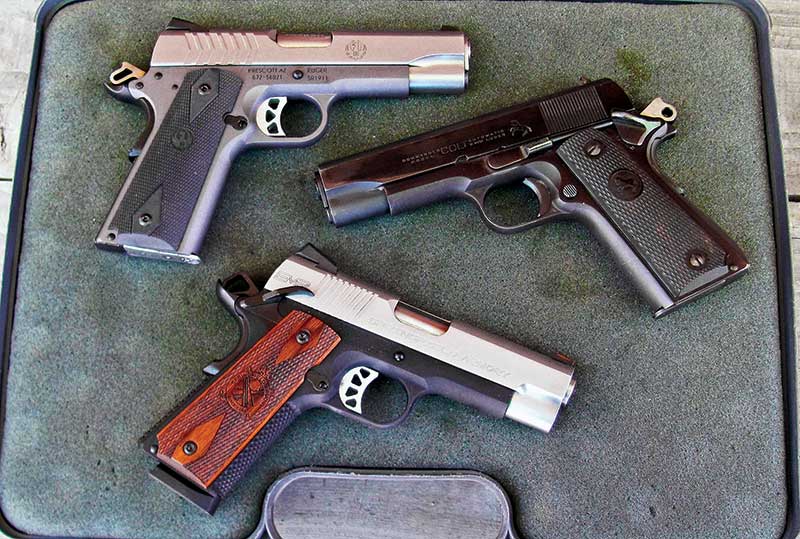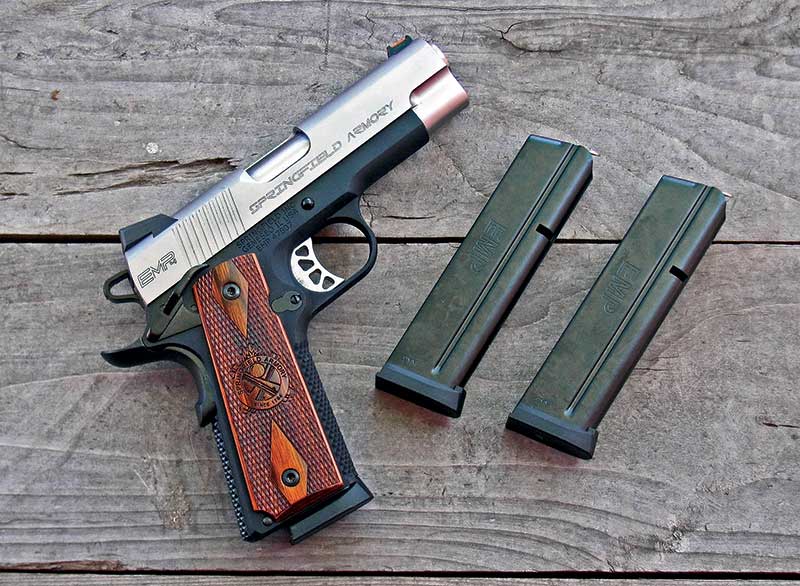A Tale of Two Nines
Springfield’s EMP4 & Ruger’s SR1911 LW Cmdr.
A few years ago I got the idea I needed a full-sized 1911 chambered in 9mm. I thought it would be easy to find one but how wrong I was. By this time virtually everyone was trying to build the smallest 9mm and/or the one with the highest capacity. However I simply wanted a traditional 1911 chambered in 9mm. Trying to find an original Colt 1911 or even a Commander chambered in the original 9mm cartridge proved virtually impossible, so my quest went unfulfilled.
Then in the fall of 2010 I felt I needed a special gun to help with my recuperation from surgery. I contacted Springfield Armory looking for a full-sized 9mm 1911. Not only did they have one, they shipped it out the next day. It was a stainless steel 1911-A1 complete with adjustable sights. Since I received this semi-auto pistol from Springfield Armory I have not only recuperated, but I may have also helped to start something, as numerous other companies — I count at least 10 — also now offer full-sized 1911’s as well as Commanders in 9mm. One even offers a long-slide 1911 in 9mm!
The SR1911 9MM LW Cmdr.
In 2011 for the 100th Anniversary of the original 1911 Government Model, Ruger came forth with their first 1911-styled .45 ACP called the SR1911. A few years later they followed with a Commander-sized .45 and now are offering a Lightweight Commander chambered in 9mm. It’s been a long time since 1949 and I let my first 9mm Commander get away. However in the past year not only has Diamond Dot gifted me with a Colt Lightweight Commander 9mm produced more than 50 years ago, Ruger has also added to the enjoyment with their version. Except for the hammer — I still prefer the old rounded style Commander hammer — the new Ruger is a decided improvement over the 1949 version.
The official name for this latest Ruger is catalog #SR 1911-CMD9-A. Overall, this is a very attractive pistol with a low-glare stainless steel slide matched up with a black anodized frame. I like this two-tone look! The slide has V-shaped cutouts at the back for easier cocking and the ejection port is oversized for positive ejection of fired cartridges. Sights on the slide are excellent, consisting of a three-dot system with a round white dot in the post front sight and two white dots in the Novak rear. Both sights are set in dovetails and the rear sight has a locking screw making it easier to adjust for windage.
The black anodized alloy grip frame is actually more of a gray color. The box says black and the spec sheet says gray, while the controls are black. These controls consist of an extended thumb safety and slide lock on the left side as well as a checkered magazine release in the right spot. The magazine capacity is nine rounds. Grips are double diamond checkered black rubber and the skeletonized trigger is lightweight aluminum, set at 41/2 pounds. The front strap is smooth while the flat mainspring housing is nicely checkered. There’s also a beavertail grip safety with a built-in memory bump Size-wise the Ruger 9mm Commander has a barrel length of 41/4″ and the weight tips things at just over 29 ounces. The 6-groove barrel has a 1:10 right-hand twist and both the barrel and bushing are stainless steel. Standard aftermarket 1911 grip panels will fit this Ruger 9mm and I normally take advantage of the situation to fancy up any of my 1911’s. However, I really like the looks and especially the feel of these rubber grip panels. I’ve spent most of my life preferring my pistols and sixguns to have great form as well as excellent function. As I have become older and my hands more tender, function, especially when it comes to grips, is starting to override form.
As with all Ruger SR 1911’s this 9mm is of the original Series ’70 design, with a titanium firing pin. The SR 1911 9mm Luger comes with two 9-round stainless steel magazines and a bushing wrench. I like everything about it and I can even live with the “modernized Commander-style” hammer.
Accurate Too
I spent several mornings test-firing the Ruger 9mm along with a second nine I will soon mention. A total of 22 different loadings were used in the Ruger Commander including 19 factory and three handloads. All testing was done at 20 yards with 5-shot groups. The most accurate loads include the Black Hills 124-JHP’s at 1,120 fps and a 11/2″ group; Remington’s 115-FMJ, 1,067 fps and 11/4″; SIG SAUER’s 115-JHP, 1,188 fps and 11/4″ and the Wilson-125 HAP which clocked out at 1,126 fps and a group of 11/2″.
My most accurate handload proved to be the Oregon Trail 147-grain hard cast flat point over 6.7 grains of AA7 for a velocity of 1,049 fps and a group of 2″. The highest velocities were recorded with the new Super Vel 90 JHP+P at 1,576 fps and the same company’s 115 JHP+P at 1,555 fps, with both grouping right at 2″.
Springfield’s EMP4 9MM
Springfield Armory is one of the major manufacturers of traditional 1911’s both in .45 ACP and 9mm and in Government Model, Commander and Officers Model sizes. However, a few years ago they decided to do something a little differently. Starting with a clean sheet of paper, the idea was to come up with a traditionally styled 1911 built around the 9mm cartridge rather than simply chambering the 9mm in a full-size 1911. The result was the EMP (Enhanced Micro Pistol).
The EMP was engineered around a new short action, with 17 redesigned parts different from the standard 1911. The goal was to come up with a more concealable 9mm package having both the look and feel of a traditional 1911. The result was a 10-shot 9mm weighing in at 27 ounces with a 3″ stainless steel match bull barrel with a fully supported ramp.
I found the EMP to be exceptionally easy to carry and shoot, and then Springfield Armory decided to improve it. Too often when things are “improved” they are in fact just the opposite. However, Springfield Armory really did improve the EMP with two basic changes; a 4″ barrel and a slightly longer grip frame. At 31 ounces unloaded, it’s four ounces heavier than the original EMP. The result is known as the EMP4 Lightweight Champion. To me it handles and shoots even easier than the original. Yes, they really did improve it.
The EMP4 is also a two-toned 9mm pistol, with a 416 stainless steel slide matched up with a 7075 black anodized aluminum frame. The slide has rear cocking serrations and the sights are excellent, consisting of three-dot steel low profile combat style set in a dovetail both front and rear. The rear sight is easily adjusted for windage and has a locking screw. The three dots consist of two white dots on each side of the rear notch matched up with a very easy to see red fiber-optic front sight.
Other Features
The black anodized aluminum frame has an extended ambidextrous thumb safety and the traditional slide lock on the left side. The grip safety is a beavertail, cut out on the top to accept the Commander-style hammer when the gun is cocked or fired. The flat mainspring housing and the front strap are both checkered in the pattern Springfield Armory calls a Posi-Lock texture, matching up with the checkered cocobolo double diamond grip panels. This gives an exceptionally secure grip. This texturing on both front and back straps and both grip panels matched up with the low recoil of the 9mm result in a pistol which will not twist in the hand on firing. Since the grip frame was designed around the 9mm cartridge it’s slightly shorter from front to back making it much easier for smaller hands to wrap around.
As mentioned the barrel length is 4 inches and is a stainless steel match bull barrel with a fully supported ramp. It’s a 6-groove barrel with a 1:16, left-hand twist. Magazine capacity is single stack and has a capacity of 10 rounds. The magazine release is in the traditional spot and the skeletonized trigger is set at 41/2 pounds. The combination of satin stainless steel slide, black anodized grip frame and cocobolo grips with the Springfield Armory logo in the center all result in an exceptionally attractive pistol. Once again, I find myself totally satisfied with the factory grips and these will not be swapped out. The EMP4 comes with three magazines, a polymer holster, a double magazine pouch, and everything is packed inside a very sturdy lockable plastic case.
A total of 18 loads were test-fired in the Springfield Armory EMP4 consisting of 15 factory loads and three handloads. The most accurate — actually unbelievably accurate — handload proved to be the Oregon Trail 122-grain hard cast flat point over 7.8 grains of AA7 for a muzzle velocity of 1,166 fps and five shots into less than 1″. This was followed by the Oregon Trail 147-grain flat point hard cast over 6.7 grains of AA7 for a 2″ group a velocity of 1,049 fps. Excellent factory loads included the Black Hills 115-JHP+P with a velocity of 1,295 fps and a 13/8″; SIG SAUER’s 115 JHP at 1,184 fps and 11/2″ and the SIG SAUER 147-FMJ with a muzzle velocity of 971 fps and a 5-shot 20-yard group of 15/8″.
With both of these 9mm pistols from Ruger and Springfield Armory now thoroughly tested presented me with a dilemma. Which one would I choose for carrying? Which one should I buy? These questions are too difficult for me to answer so I took the easy way out. I bought them both and they will receive equal carrying time.
Final Thoughts
It’s very interesting to see how things work out over the years. When I was a young shooter you could always count on seeing articles on a regular basis of the “.45 versus 9mm” type. The .45 always won and so-called “serious” defensive handgun proponents always downplayed the 9mm. This was almost always based on full metal jacketed ammunition. Now we have excellent hollow point designs in several weights and from dozens of manufacturers providing excellent self-defense capabilities and have totally destroyed the argument.
Then in the late 1980’s to early 1990’s the .40 S&W began to push the 9mm aside. Now the .40 S&W is on the downhill slide and the 9mm continues to rise. Since we now have so much excellent 9mm ammunition available, this, coupled with much less recoil than either the .45 or .40 — plus the much lower cost for practice ammunition — makes the choice of a 9mm highly attractive.








